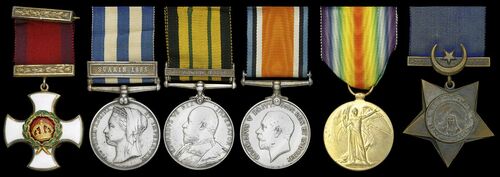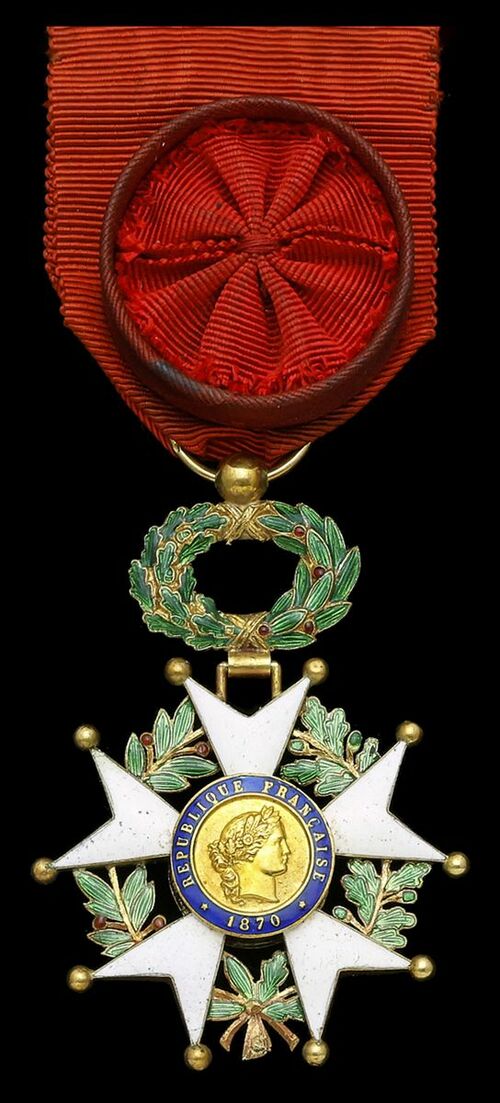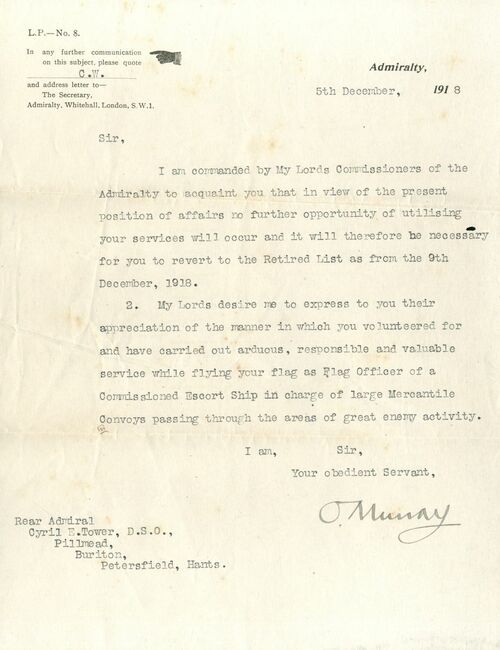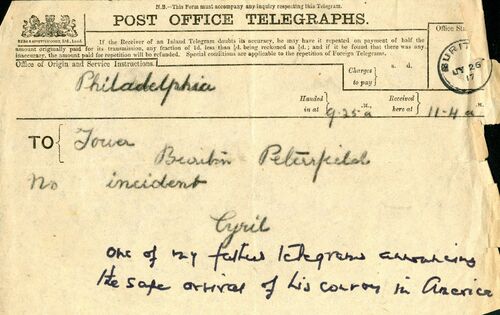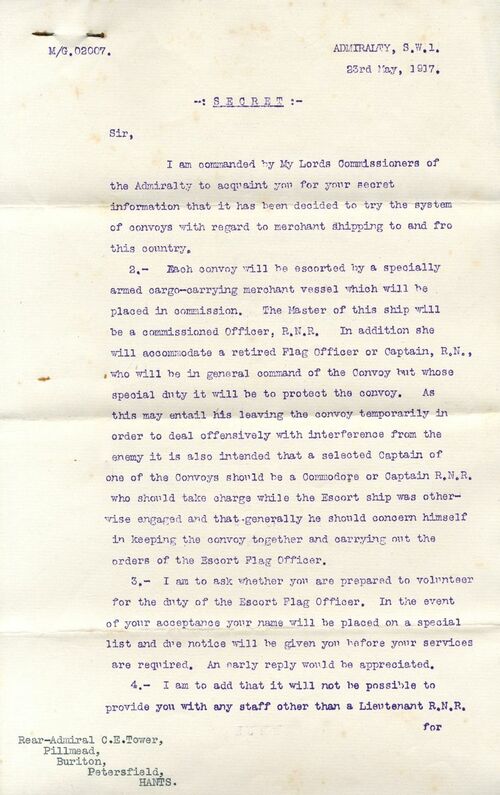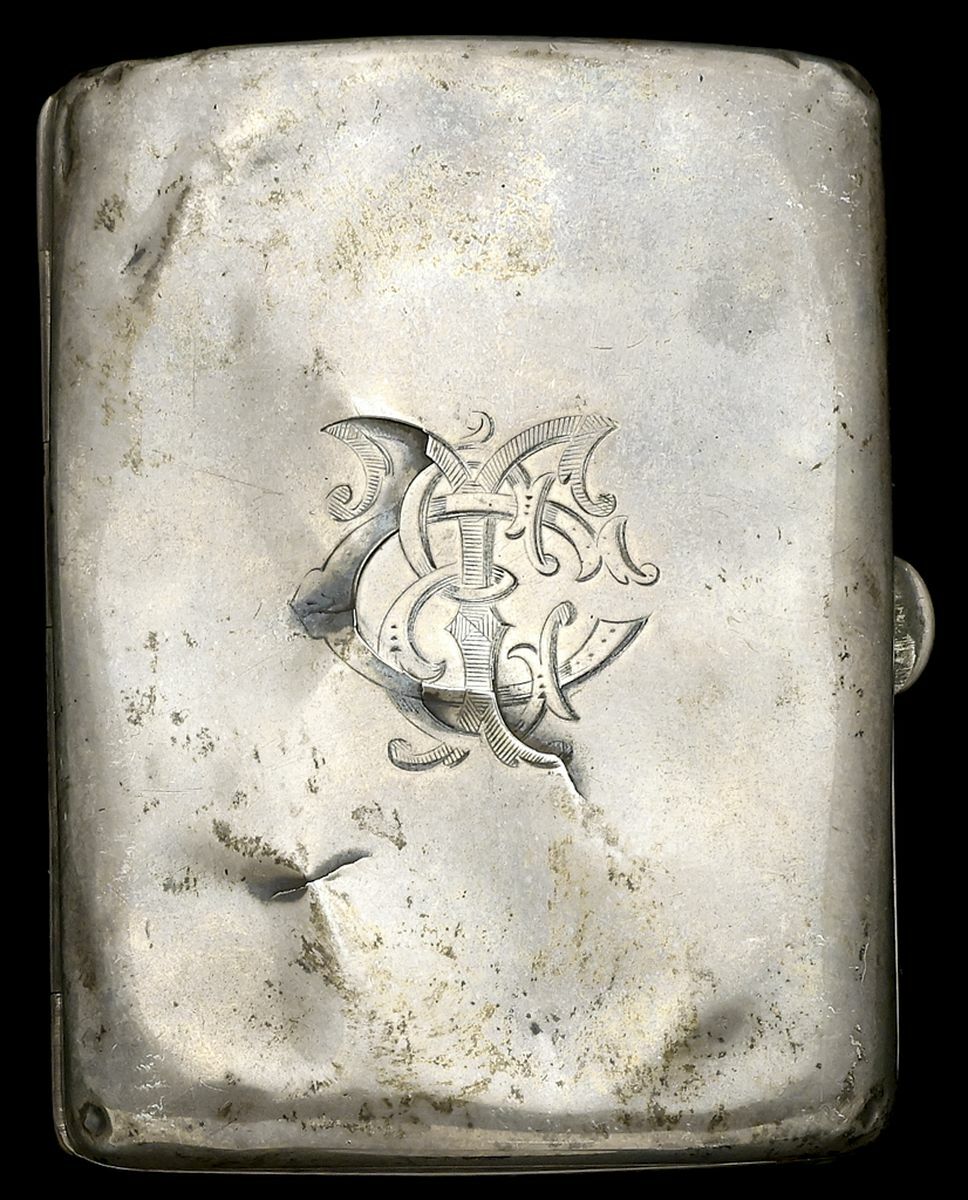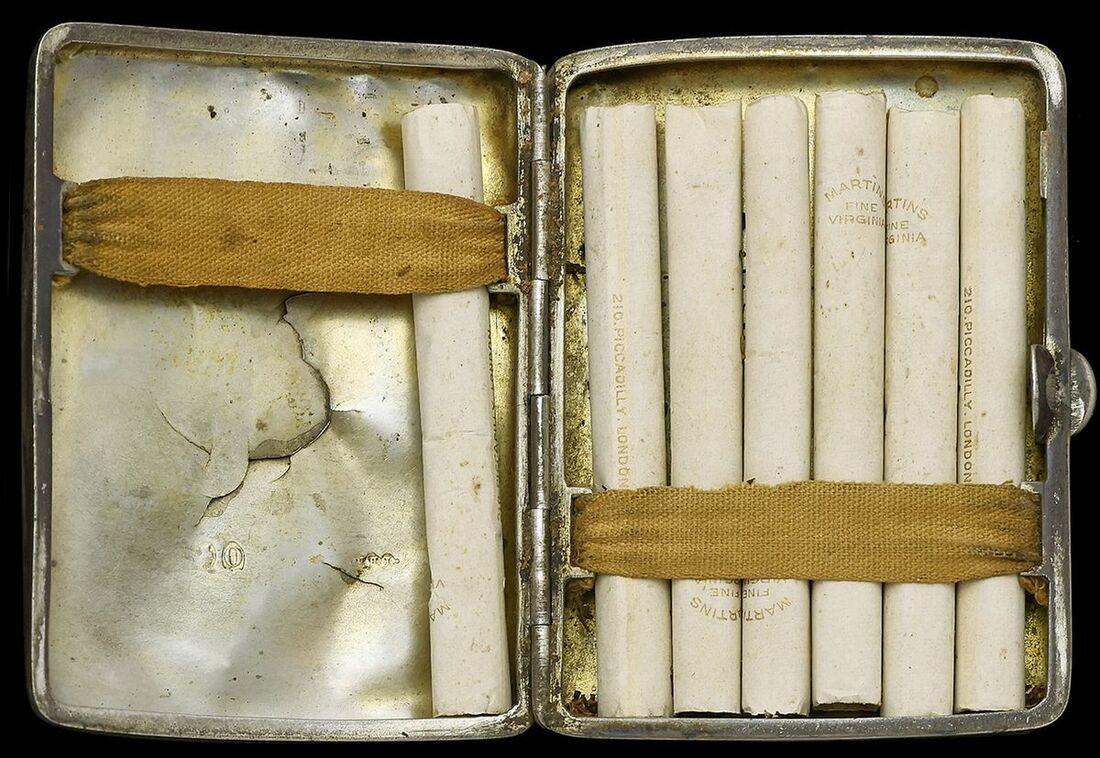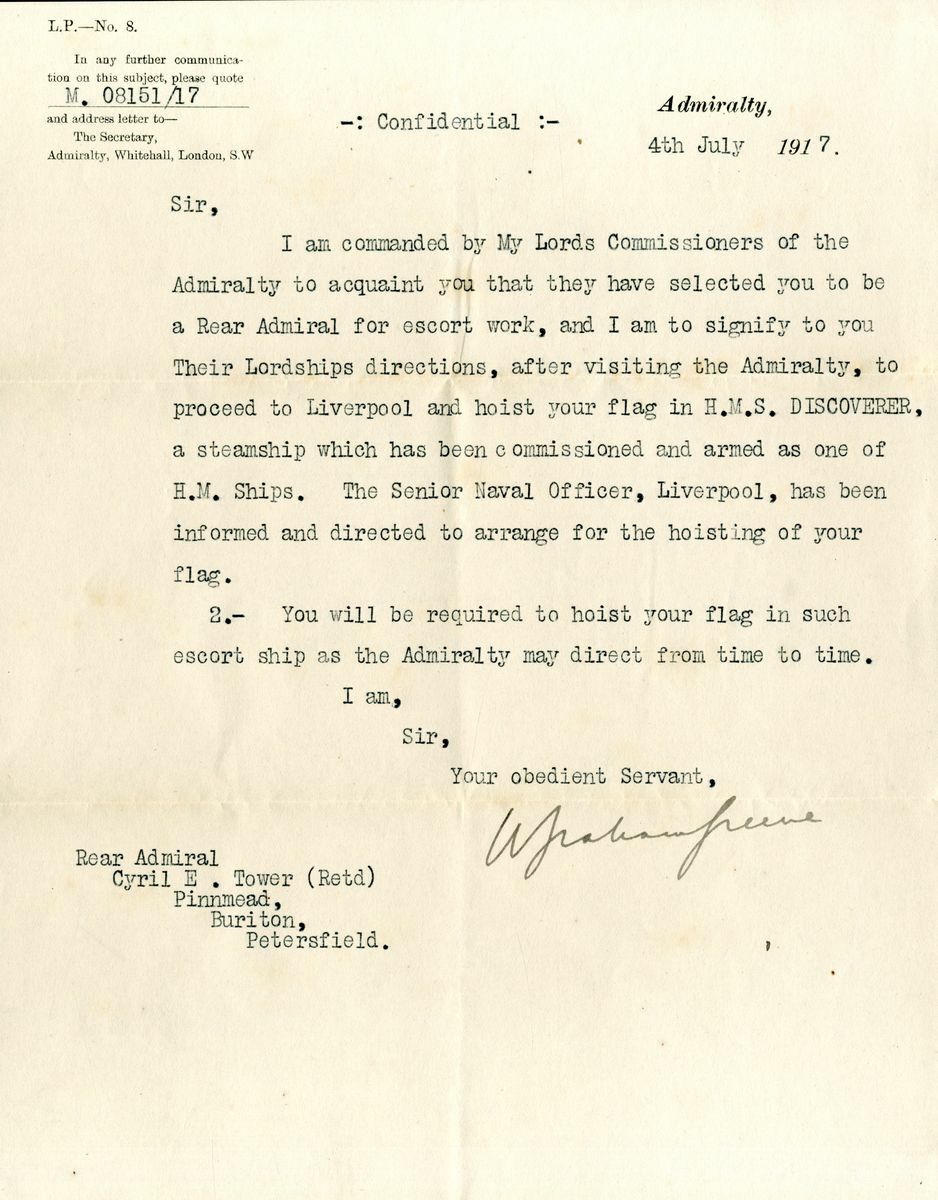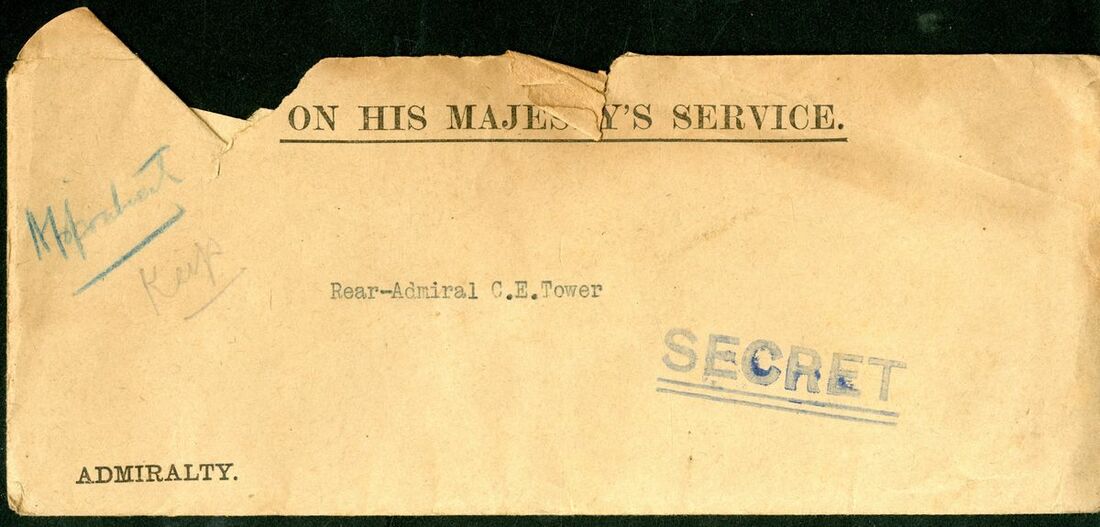Auction: 23002 - Orders, Decorations and Medals
Lot: 82
The remarkable and well-documented 'Atlantic Convoys 1918' D.S.O., Legion of Honour group of seven awarded to Admiral C. E. Tower, Royal Navy, a well-regarded Officer of the late Victorian Navy who saw action ashore at Suakin with Coquette, led a shore party during the Nicaragua Crisis of 1894-1895, and commanded Harrier hunting pirates and gun-runners in the Red Sea
Set to end his career as Captain of the Dockyard, Deputy Superintendent and King's Harbour Master, Portsmouth, he voluntarily emerged from retirement to command a Commissioned Merchant Cruiser in 1917
D.S.O., G.V.R., silver-gilt and enamel; Egypt and Sudan 1882-1889, dated reverse, 1 clasp, Suakin 1885 (Sub: Lieut: C. E. Tower. R.N. H.M.S. "Northumberland".); Africa General Service 1902-56, 1 clasp, Somaliland 1902-04 (Commr C. E. Tower, R.N. H.M.S. Harrier.); British War and Victory Medals (R. Adml. C. E. Tower.); Khedive's Star 1882; France, Republic, Legion of Honour, breast Badge, silver-gilt and enamel, loose enamel centre to D.S.O., minor contact wear to Victorian campaign medals, overall good very fine (7)
D.S.O. London Gazette 1 January 1918, his service records state:
'Awarded D.S.O. for service in charge of convoy escorts.'
Legion of Honour, permission to wear granted 5 August 1911 as per ADM 196/42/26.
64 'Suakin 1885' clasps awarded to H.M.S. Coquette.
Purchased privately from the family and offered here at for the first time at public auction.
Cyril Everard Tower was born at Chilmark, Wiltshire on 3 December 1861, the son of Ellen and Canon Charles Tower of Chilmark, where his father was rector of the local church. Educated at Lancing College the younger Tower entered the Royal Naval College as a Cadet on 15 July 1874. Posted to the training ship Britannia he served with her until 21 July 1976.
Brief service with Duke of Wellington and Spartan took him through to 20 February 1877 when he was appointed Midshipman with Undaunted. After further service with Druid and Tamar he was posted ashore to Excellent and commissioned Sub-Lieutenant on 3 December 1880.
The Suez and Suakin
Returning to sea with Northumberland from 17 February 1882 Tower served with this vessel during the Urabi Revolt in Egypt. During the British response, while the Battle of Tel-El-Kebir played out to the west, Northumberland was employed in keeping the Suez Canal open. Tower's service records states that he was 'Employed at occupation of canal with small arm companies'.
Leaving the ship in January 1883 he was posted to the gunboat Coquette while still in the Mediterranean and promoted Lieutenant with her on 30 June 1884. He was still with this vessel when she deployed shore parties to help secure the vital Red Sea port of Suakin from Mahdist forces in 1885. Tower was one of three Lieutenants stationed with a shore party of 64 men under the command of Lieutenant H. E. FitzCrowe.
Nicaragua. Constantinople and the Red Sea
Posted to the Torpedo Boat T.B.62 he participated in the manoeuvres of 7 July 1887 before removing to the corvette Cleopatra in November 1888. Joining Canada at Portsmouth on 21 July 1892 as 1st Lieutenant Tower remained with her when she was posted to the North America and West Indies Station the next year.
It was in this role that Canada responded to the Nicaraguan occupation of the Miskito kingdom- referred to as the Mosquito Reserve- in 1894. The British and American navies both landed troops and forced the Nicaraguans to withdraw, though only briefly as it transpired. Tower commanded the party of marines and bluejackets which landed from Canada to protect British civilians, his service papers state:
'Capt. Wilson brings to notice conduct + ability during the landing of a party from 'Canada' at Blewfields [sic] during disturbances in the Mosquito Reserve'
Tower was recommended for promoted by Admiral Sir John Hopkins while serving with the Battleship Anson and the next month he was advanced Commander on 22 June 1897. Returning to H.M.S. Northumberland- by this time a depot ship- Tower commanded her in this role until an active posting became available commanding H.M.S. Harrier.
Joining her in March 1901 she was soon ordered to the Mediterranean Station, replacing Melita as the special service vessel at Constantinople in November. Here Tower was recommended for promotion for his 'tact + discretion' in what was certainly a difficult role in a tense region of the world. After a visit to the Danube they entered the Persian Gulf in 1902 on anti-piracy duties. The Hampshire Telegraph gives us some details stating that 'he helped in the suppression of piracy between Hodeidah and Lith' along with an impromptu squadron of three dhows.
Transferring to the waters around Somaliland Harrier took part the East India Squadrons attempts to blockade the region from the gun-runners arming the followers of Sayyid Muhammed Abdullah Hassan- 'The Mad Mullah'. Here Tower was again 'strongly recommended for promotion by C in C Medn. on account of the excellent work done by him in suppressing piracy in the Red Sea'.
H.M.S. Illustrious and Portsmouth Dockyards
This time the recommendation came through and not long after leaving Harrier he was promoted Captain on 30 June 1904. Joining Eclipse in February 1905 he spent much of the next decade commanding vessels on station or undertaking war and signals courses until coming to command Illustrious in April 1908.
In command of this vessel Tower's career took a turn for the worst, he incurred their Lordship's Displeasure for grounding the warship in 1908. Perhaps shaken by this mistake he was taken to a court of inquiry in 1909 and held to blame for a collision between Illustrious and Amethyst. In spite of these events he continued to command, receiving a glowing report in November 1909 from Rear-Admiral Bush who- regardless of the evidence- stated: 'a zealous & painstaking officer. Handles his ship well'.
Tower had one final posting afloat before the Great War, aboard the battleship Swiftsure which he joined in February 1910. It is likely with her that he came to be awarded the Legion d'honneur although no records survives as to how. Tower was appointed to the role of Captain of the Dockyard, Deputy Superintendent and King's Harbour Master, Portsmouth on 1 February, 1912.
The Great War and a Return to Duty
He was still serving in this role on the outbreak of the Great War and remained in it for the opening years. One report upon him made in January 1915 stated:
'Work has been most satisfactory carried out under Capt. T's orders.... I am of opinion that Capt. T. is a little dependent on his subordinates.... he perhaps lacks a little determination "to get things done"....'
Perhaps a mixed review but nevertheless suggesting that Tower was performing his role well even under the stresses of a global war. Promoted Rear-Admiral on 2 June 1915 Tower retired at his own request later that month on 28 June. Despite that he did not leave the role immediately but continued to work until 29 June 1916.
However it seemed that life outside of service was not to his taste and when Admiral Tower received a letter asking if he would volunteer his services for a convoy escort duty he leapt at the chance. As unrestricted submarine warfare hit home the Admiralty decided to send convoys through trouble hotspots with commissioned escort ships. Tower was posted first to the converted fishing ship Discoverer before later joining Camito, a former passenger ship. The best clue to his whereabouts in this period is an annotated telegram to his family stating that he had arrived in Philadelphia. A remark on Tower's service records sheds light on his duties stating:
'On reverting to retired list, T. L. express their appreciation of the manner in which he volunteered for and have [sic] carried out arduous, responsible & valuable service while flying his flag as Flag Officer of a commissioned escort ship in charge of large mercantile convoys passing through areas of great enemy activity.'
Tower was awarded the D.S.O. for his efforts and was invested with it by The King at Buckingham Palace on 4 May 1918. Returning to the Retired list on 9 December 1918 he was promoted Vice-Admiral on 2 November 1919. Tower settled at Ellerslie, Farnham receiving his final advancement to the rank of Admiral (retired) on 1 August 1924. He died suddenly of heart failure on 20 January 1929 and was survived by his son Commander Cyril Francis Tower, Royal Navy (for his awards and medals see Lot 78); sold together with copied service papers and medal rolls as well as an original personal archive comprising:
i)
Two obituaries.
ii)
A brass plate depicting a coat of arms.
iii)
A Telegraph.
iv)
A silver cigarette case with its original contents.
v)
Contemporary copies of service records, with a covering letter addressed to the recipient's widow.
vi)
A number of funeral orders of service.
vii)
A great quantity of correspondence both personal and official.
viii)
Several religious declarations.
ix)
Written and typed orders relating to the recipient.
x)
1911 Exmouth term reunion dinner guestlist and covering letter.
xi)
A leather document folder containing the above archive.
Subject to 20% VAT on Buyer’s Premium. For more information please view Terms and Conditions for Buyers.
Sold for
£4,200
Starting price
£2200

